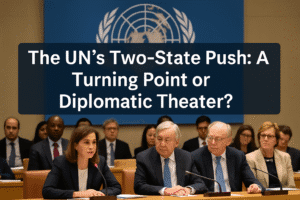The UN’s Two-State Push: A Turning Point or Diplomatic Theater?
A major UN conference backed a concrete “New York Declaration” demanding Israel commit to Palestinian statehood, with unprecedented working groups tackling security and governance. Britain issued an ultimatum: recognize Palestine by September unless Israel agrees to a Gaza ceasefire and aid access, while France pledged unconditional recognition.
Crucially, Arab states joined in condemning Hamas’ October 7 attacks—a significant diplomatic shift. The plan requires Hamas to disarm and cede control to the Palestinian Authority, aided by international peacekeepers. Starvation in Gaza accelerated global consensus, sidelining the boycotting US and Israel.
With the September UN General Assembly looming, this marks the most substantive international roadmap in decades, though lacking Israeli participation casts doubt on implementation amid urgent humanitarian collapse.

The UN’s Two-State Push: A Turning Point or Diplomatic Theater?
The Core Shift
The New York Declaration marks the most concrete international roadmap for Israeli-Palestinian peace in decades. Unlike past symbolic resolutions, it establishes eight specialized working groups tackling thorny issues: security guarantees, governance transitions, and refugee rights. This structure suggests recognition that statehood alone won’t resolve 80 years of conflict without institutional scaffolding.
The Pressure Calculus
Britain’s September deadline for Palestinian recognition isn’t just posturing—it weaponizes diplomatic recognition as leverage. By conditioning it on Israel’s acceptance of a ceasefire, aid access, and peace talks, the UK reframes statehood as a consequence of cooperation, not its precondition. France’s unconditional September pledge further fractures the Western consensus, isolating the US and Israel.
Arab League’s Pivotal Move
The declaration’s condemnation of Hamas’ October 7th attacks represents a strategic rupture. Major Arab powers are publicly prioritizing long-term stability over ideological solidarity—a shift Israel dismisses as “appeasement” but which could reshape regional dynamics.
The Gaza Transition Puzzle
The plan’s demand that Hamas surrender weapons to the Palestinian Authority (PA) reveals critical tensions:
- The PA lacks legitimacy in Gaza and military capacity to disarm Hamas
- Proposed “international stabilization forces” risk becoming permanent peacekeepers
- Netanyahu’s rejection makes transitional governance currently unworkable
Starvation as Diplomatic Fuel
Ongoing famine warnings in Gaza—explicitly cited in the declaration—transformed the conference’s urgency. Images of malnutrition undermined Israeli claims about aid access, turning humanitarian catastrophe into a geopolitical liability that accelerated international consensus.
Why the US Boycott Backfires
American absence ceded agenda-setting to European and Arab states. The resulting declaration includes elements Washington opposes (like swift recognition timelines), demonstrating how diplomatic vacuums get filled. This may force Biden’s hand before September’s UN General Assembly.
The Real Stakes by September
Two deadlines now loom:
- Britain’s 8-week window for Israeli concessions
- UNGA 2025 where recognition votes could multiply
This creates a rare “action-forcing event” in a conflict defined by stagnation.
This conference reflects global exhaustion with the conflict’s intractability. The focus on phased implementation acknowledges past failures of grand declarations. But without Israeli participation or US backing, the plan risks becoming another well-intentioned blueprint doomed by ground realities. The true test lies in whether starving Gazans see improved aid access before diplomatic deadlines expire.
You must be logged in to post a comment.